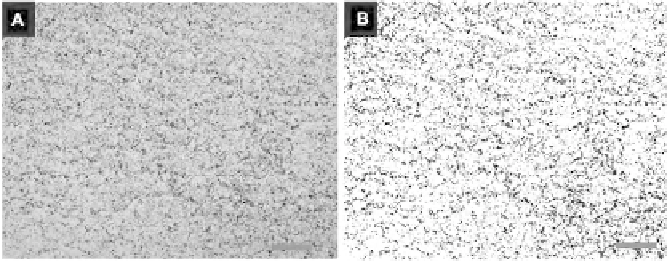Environmental Engineering Reference
In-Depth Information
Lemiski et al. (2011)
conducted spot-minipermeametry analyses of the
Alderson Member. They demonstrated that, of the reservoir units, bioturbated
heterolithic intervals make the most significant contribution to the overall stor-
age and producibility of gas from the Alderson Member. The permeability is
particularly enhanced in the
Phycosiphon
-dominated sandy mudstones (
Fig. 5
).
Lemiski et al. (2011)
further suggested that the vertical transmissivity of gas
is substantially increased in the bioturbated levels. Their study concluded: “bio-
turbated zones may represent an important means of delivering gas from the
tighter, encapsulating matrix. In other words, the burrows can act as biogenic
'fractures' (but) with higher surface area”.
4.3.4 Cryptic Biogenic Heterogeneities
Cryptic biogenic heterogeneities (CBH) result from one of three processes:
(1) meiofauna disrupting sedimentary lamination, which is referred to as crypto-
bioturbation; (2) some
Macaronichnus
behaviors, which preserve the vestigial
sedimentary texture by implementing grain-selective deposit-feeding behaviors;
and (3) eradication of sedimentary lamination by burrowing animals that churn
the sediment. The effects of cryptobioturbation and
Macaronichnus
-like burrows
on reservoir properties can be important (
Gingras et al., 2002b; Gordon et al.,
2010; Pemberton and Gingras, 2005; Tonkin et al., 2010
). Although cryptobio-
turbated fabrics appear homogeneous (
Fig. 14
),
Gingras et al. (2002b)
and
Gordon et al. (2010)
demonstrate that the burrow fills relative to the unburrowed
matrix commonly proffer a dual-porosity flow medium. Therefore, fluid produc-
tion out of cryptobioturbated media presents challenges in terms of the presence
of tortuous fluid-flow pathways, permeability streaks, diffusion in and out of
the burrowed zones, and complex relationships between bulk porosity and bulk
permeability (
Gingras et al., 1999; Pemberton and Gingras, 2005
). On the other
hand, cryptically bioturbated and
Macaronichnus
-dominated sands have been
shown to produce comparably isotropic flow units that may be amenable to
FIGURE 14
(A)
Macaronichnus
-burrowed sand. (B) The same field of view showing image-
enhanced burrow structures. The burrow halo is defined by dark grains, and the white area is the
burrow fill (scale bar = 0.5 cm).







Search WWH ::

Custom Search